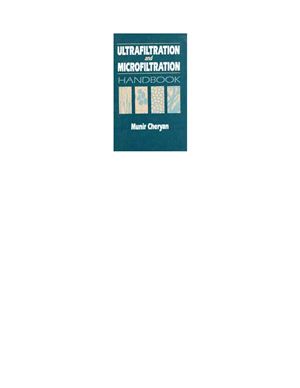A Technomic Publishing Company, 1968. - 615 pages
Preface
Going back over the events in the membrane world since the first edition of Ultrafiltration Handbook, one cannot help being pleasantly surprised at the remarkable progress in many aspects of this ubiquitous technology. The development of the Sourirajan-Loeb synthetic membrane in 1960 provided a valuable separation tool to the process industries, but it faced considerable resistance in its early days. The situation is different today: membranes are more robust, modules and equipment are betterdesigned (if the feedstream can be pumped, the chances are one or more of the modules available today will be able to handle it), and we have a better understanding of the fouling phenomenon and how to minimize its effects. Most important, costs have come down significantly, partly because of maturing of the technology and partly because of competition from an increasing number of membrane suppliers and original equipment manufacturers (OEM). Simultaneously, several company mergers and marketing alliances occurred that should provide a firmer footing from a business viewpoint. Developments in nanofiltration, gas separations, pervaporation, and bipolar membrane electrodialysis have widened the applicability of membranes, thus attracting even more attention. This revision of the Ultrafiltration Handbook is an attempt to catch up with these developments. The main themes remain the same and familiar to readers of the previous edition, but each chapter has been updated and revised while keeping the ''handbook" flavor intact.
Preface
Going back over the events in the membrane world since the first edition of Ultrafiltration Handbook, one cannot help being pleasantly surprised at the remarkable progress in many aspects of this ubiquitous technology. The development of the Sourirajan-Loeb synthetic membrane in 1960 provided a valuable separation tool to the process industries, but it faced considerable resistance in its early days. The situation is different today: membranes are more robust, modules and equipment are betterdesigned (if the feedstream can be pumped, the chances are one or more of the modules available today will be able to handle it), and we have a better understanding of the fouling phenomenon and how to minimize its effects. Most important, costs have come down significantly, partly because of maturing of the technology and partly because of competition from an increasing number of membrane suppliers and original equipment manufacturers (OEM). Simultaneously, several company mergers and marketing alliances occurred that should provide a firmer footing from a business viewpoint. Developments in nanofiltration, gas separations, pervaporation, and bipolar membrane electrodialysis have widened the applicability of membranes, thus attracting even more attention. This revision of the Ultrafiltration Handbook is an attempt to catch up with these developments. The main themes remain the same and familiar to readers of the previous edition, but each chapter has been updated and revised while keeping the ''handbook" flavor intact.

